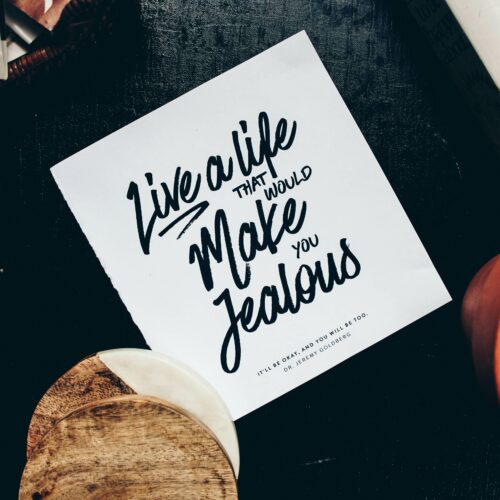It’s August, and I’m in the midst of an authenticity kick, riding high on a gorgeous West Coast vacation.
(In L.A., of course, authenticity is the name of the game. Especially if your authentic calling is to impersonate other people.)
I’m inspired, in part, because I LOVE to travel. It fires me up. It makes me feel confident.
Most of all, it reminds me to claim my power as a business owner. As a woman crafting and living her flipping DREAM LIFE.
So how can you step into your power as authentic business owner?
Simple: Stop hiding. Commit to injecting a boatload of YOU in your personal brand.
When you start showing up in your website, you’ll not only build your courage, you’ll grow your bottom line.
Here are three fundamentals to get you started.
1. Put your face on your website.
Good grief, it amazes me how many people do not have a photo of themselves on their website. (Or on their LinkedIn profile, for that matter.)
So many “professional” sites eschew faces entirely that I’m afraid small business owners take face-free marketing as a hallmark of expertise and success.
You’re missing out BIG TIME if you don’t show your face—because scientifically speaking, humans crave face time. We’re drawn to them by physiological impulse, more quickly and readily than anything else on a screen.
(That’s why so many Facebook ads include random pictures of people with weird eyeglasses, scary or twisted facial expressions, etc. We’re biologically programmed to do a double take when a) we see a face, and b) we’re confronted with something that doesn’t meet our expectations.)
Long story short, YOU NEED A PICTURE of yourself on your website. Otherwise you’re asking strangers on the internet to trust that you are a real person even though you refuse to put your money where you mouth is. #catfishing
Think about it: would you trust someone who asked you for money with a ski mask or brown paper bag on her head?
Probably not. But if your website doesn’t have a photo, that’s essentially what you’re doing.
If you run your biz all by yourself, or you’re the main point of brand contact with a team of contractors, make sure it’s your face site visitors see.

(Check out this example from Carrie Coleman. She’s the gorgeous photographer behind my website photos, and wisely, she doesn’t shirk the lens.)
At minimum, you need is a professional headshot somewhere on your site. (The About page is an obvious choice.) If you’re ready to go for gold, slap your mug absolutely everywhere.
If you work with a team, you can have a group photo. Just make sure you give a little room to each individual face. 
(Check out this screenshot from Ghostly Ferns, a NYC-based creative agency. They do an awesome job showcasing their peeps.)
So get ready for your close-up!
2. Write in the first person.
You probably talk in the first person. You probably write your emails in the first person. And when you write blog posts, you probably use the first person, too.
Why is that?
Because our default communication setting, as humans, is conversation.
We want to engage people in conversations. And in order to do that, we structure our language as a dialogue between two people: you and me.
Your website should be a continuum of this conversational tone. Your copy should read like it was written by one real person, or a group of people, speaking directly to another real person.
When you make the switch in your website copy from third to first person, you instantly build trust, connection, and a sense of rapport with your visitors.
So here’s how you make the magic happen:
If you are the sole employee or a creative freelancer, use first person singular. (That’s I, me, mine, etc.)

(Here’s a great example on the home page of an independent designer. You know she’s the one behind the biz. If you call, she’ll pick up the phone.)
If you lead a team or a group of freelancers, use first person plural. (That’s we, us, ours, etc.)

(Here’s an example from a creative branding and design agency that I wrote the copy for. They’ve got multiple folks under one roof, and this noun choice makes it easy for you, the reader, to understand and connect with their team.)
These concepts apply across your website, but they are ESPECIALLY true on your About page.
This is THE place site visitors come to make an emotional connection with the person on the other side of screen. So do NOT have a third person bio unless you preface it with a first-person intro. Bonus points for a header that acknowledges the switch (scroll to the bottom of this page for an example).
Easy change. big payoff.
3. Keep your message front and center.
I’m a rabid believer in the power of a heart-centered message. Every minute, someone out there needs to hear your version of fundamental truth: how to solve a problem you’ve grappled with and what that problem—and its solution—means in the greater context of their lives.
In short, people need help—and they need it from you. Because only you offer your unique blend of values, worldview, and life lessons.
The mechanics by which you solve a problem may be similar across your industry, but the personal touches are all your own. And people buy the person long before they buy the product.
Here’s an example of what I mean from someone who’s done VERY well in her industry.

Sarah Jenks is a health coach. Now, there are a LOT of health coaches in the world. What makes one more appealing than another?
Why does one person get talked about to friends and family and cited as a memorable expert when she (arguably) has the same technical skills as many others in her field?
Because she has a message that radiates from every corner of her website.
Jenks’ message is simple and easy to grasp: “live more, weigh less.” Her philosophy revolves around cultivating a self-love mindset long before you can effectively lose weight. And that concept resonates with the hundreds of women who have become her clients because it strikes a fundamental chord in their hearts.
Jenks’ clients needed help. They found an expert who not only understood how to solve their problem, she shared their values of compassion and love. Because she was able to identify her core message and create marketing collateral and programs to reflect it, she was able to attract her ideal clients and set herself apart from everyone else.
Like Jenks, you want your deep truth to radiate.
Weave your authentic message throughout your website copy, so visitors recognize you as their long-lost soulmate.
When you do, they’ll be hooked. And the life-changing conversations can actually begin.
And if you aren’t yet clear on your message, or you don’t know exactly how to incorporate what you do believe into your website, I’ve got you covered.
I’ve opened up my calendar so you can sign up now for an Authentic Message Clarity Call. This is a special 45-minute session in which I’ll help you get clear on where you are now and what’s standing in the way of sharing your message. I’ll also give you personalized recommendations and mindset shifts to help you move forward.
Each Clarity Call is valued at $100, but you’re my inner circle and I’d love to help you for FREE. If you’re interested, email me directly at ehd@elizabethhopederby.com.
Adopt these 3 fundamentals and you’ll create a personal brand website that’s deliciously…personal.
Because you deserve all the sunny success and visibility you can handle…even if that means you start Vogue-ing on a boardwalk in Huntington Beach.



